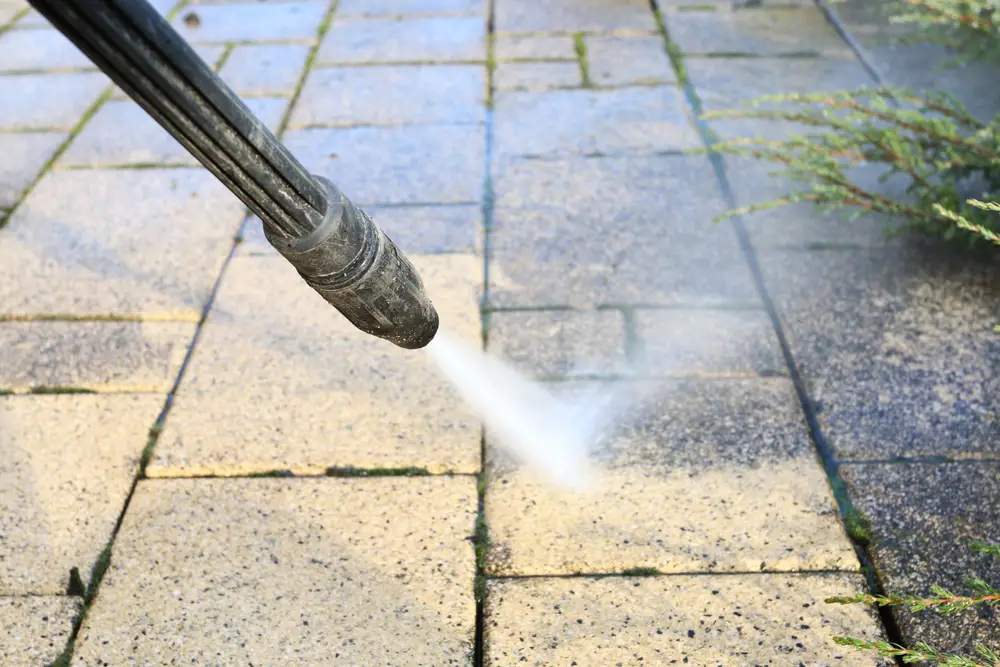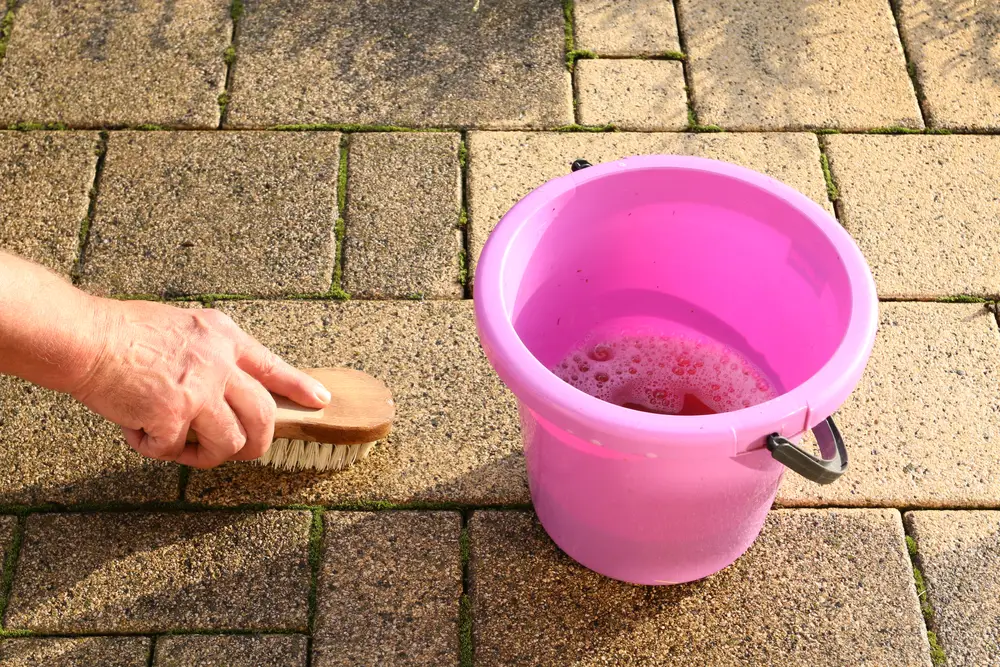With summer well on the way and Spring in bloom, it’s time to get your outdoor areas ready, including the patio. While you may be sorely tempted to reach for your high-pressure washer to do this, you may want to hold onto that thought for a minute.
High-pressure washing can be bad for your patio as it can cause damage like pitting, surface marks, degradation of the stone, and removal of mortar between the paving stones, causing them to come loose. Damage to the patio is usually caused by using too much pressure rather than the pressure washer itself.
Knowing what level of pressure you should use with your patio and whether your washer has the option to use a lower pressure will determine whether you can use your washer or whether you need to revert to a less violent cleaning solution for your patio.
The Problem Isn’t The Washer

When it comes to using a pressure washer, most folks don’t take the time to consider the application they are buying it for, whether it’s for cleaning their car, driveway, or patio, and this often leads to using the wrong pressure for the job, which results in damage to the object or area being washed.
When buying a pressure washer, always consider what you will be using it for. Purchase one that will work appropriately for your intended use, purchase one that has a variety of pressure settings, or opt for another cleaning appliance that won’t damage your patio.
Of course, the convenience of ‘point, spray, and clean’ is hard to beat when compared to using other more manual options like sweeping or using a standard pressure hosepipe, but those options won’t damage your patio stones or concrete.
Good Quality Washers Have Adjustable Pressure
Manufacturers are well aware that homeowners use pressure washers for a variety of uses, which is why most high-quality pressure washers come with a variety of pressure options. Setting options are added to decrease the pressure or spread out the jet to decrease the impact of the water on surfaces.
The leading cause of damage to patios using a pressure washer is that people tend to use too much pressure, and this is where surface damage like pitting and removal of mortar between the stones or tiles can occur.
If you could dial down the pressure or diffuse the jet to reduce the surface impact of the water jet, you could safely use a pressure washer on your patio, and if you can buy one that has those options included, you can safely use your pressure washer to clean your deck.
Use The Right Nozzle To Prevent Patio Damage
Most people underestimate the power of water at high-pressure. I have witnessed a friend try to pressure wash a wooden deck at extremely high pressure and the stream of water tore right through the wood.
Water pressure is a mighty force but can be extremely useful when appropriately used. When looking at a pressure washer for your patio, consider the different types of nozzles you can use.
One that dissipates water into a more delicate spray or lower power jet would be more beneficial to cleaning your patio than one that sends out a powerful blast of water that could move your truck!
Cleaning wheels and cars are different from cleaning patios, so don’t use the same nozzle to clean your patio as the one you use to clean your vehicle. So what level of pressure should you use on your patio?
What Level of PSI Should You Use In Your Pressure Washer?
If you have purchased a pressure washer and want to use it to clean your patio you want to be sure that you are using the correct PSI. The correct PSI to use for a patio will typically range between 1800-2300 PSI. Patios are made of different materials, most commonly in the U.S you will find patios made of (i) bricks, (ii) concrete, or (iii) stone.
1800-2300 PSI is typically considered within the “medium range” of PSI for a pressure washer. Any higher than this and you begin to risk damage to your patio so ignore the urge to go with a higher pressure.
Concrete deserves a special mention here as concrete patios vary in porosity. Some concrete mixes are denser than others but you won’t be able to tell how dense your concrete patio is until you start damaging it with high-pressure water. Up to 3000 PSI is suitable for more porous concrete, however, we strongly insist that you start at the 1800-2300 range.
What Other Damage Can A Pressure Washer Do To A Patio
Aside from the physical damage to the stones or tile, a pressure washer can also remove paint or protective coatings and spray debris like stones and dirt around the immediate area, which can crack or chip windows and damage walls.
In extreme cases, it can even send stones flying into car windows or doors and damage vehicles or even people, including yourself.
If you have concrete slabs, it should be worth noting that if they are new, say a year old or less; they are more likely to be damaged by pressure washing than more aged concrete.
Tiles and stone can suffer damage to the point where they need replacing, and that would be a costly mistake, so put down the pressure washer and see how you can clean your patio with and without a washer safely.
How To Clean Your Patio Without Damaging It
Cleaning stains off your patio can be done without a pressure washer, and how you do it will greatly depend on the type and severity of the stain you have.
Cleaning Water Based Stains

These are the easiest to clean, and you don’t need to blast them to Mars with your pressure washer to do it. With stains like soda or red wine, you can use warm water and a rag to wipe off the stain.
If the stain is a little stubborn, you can dilute some bleach in a 1:10 solution, which should remove any remnants of the stain.
Removing An Oil Based Stain
If you drop some spaghetti sauce or motor oil on your patio tiles, don’t reach for the pressure washer immediately as you could ingrain a stain into the tiles or stone. Instead, use a cloth or a paper towel to blot it out, and do this as quickly as possible.
Many people mistake wiping or rubbing stains when you need to blot them to prevent staining. Once you have blotted away as much of the stain as possible, add an absorbent powder over the stain and let that do its work.
Leave the powder for 24 hours, and then repeat the process until all the oil has been absorbed. You may also be able to find a tile cleaner that could remove the stain – remember NEVER wipe an oil stain, ALWAYS blot it.
Alternatives to Pressure Washing Your Patio
What if you don’t have a pressure washer or you have already tried pressure washing your patio and you noticed that it damaged the pavers or concrete? Luckily, there are a variety of effective alternatives to power washing your patio. It’s true, that using a pressure washer is by far the fastest method, but just because it is fast does not make it the best for your patio.
Tools You Will Need:
- Cleaning brush. Personally, I prefer patio scrub brushes with long handles that are specifically made to clean patios, but you can use any stiff bristled brush.
- A bucket.
- Degreaser. Alternatively, you can use dish soap, however, I have found that patio degreasers are more effective on the first go-round.
- COMBO PACK — Stiff bristles on the SWOPT 10” Deck Brush provide heavy-duty scrubbing power for rough & textured surfaces. Clean decks, sidewalks, patios, driveways, & garage floors for longer periods with the SWOPT 60” EVA Foam Comfort Grip Wooden Handle.
- INTERCHANGEABLE — With the SWOPT cleaning system, all your cleaning tools use a single interchangeable handle, so that indoor cleaning heads can be “SWOPT” for outdoor tools at the push of a button. Say goodbye to cluttered cleaning closets!
- SPACE SAVING — Don’t buy separate cleaning supplies like a mop, broom, and duster! The wood handle can be used with all SWOPT heads, making it easy to stay organized. Less handles to save more money and closet space.
- SOLID HANDLE CONNECTION — Your handle will never twist loose again! Our Snap Lock Technology securely attaches each cleaning head to your handle, keeping it from twisting loose during use. The locking mechanism allows you to change cleaning heads quickly.
- SWOPT CLEANING CO — Our products are built to last — we believe in the highest quality, finest craftsmanship and innovative design.We back them up with a lifetime warranty, so you can rest assured your cleaning tools will be effective for years to come.
Here are the steps that you should take to clean your patio:
- Start with clearing the patio of any furniture and sweeping or leaf blowing any leaves and other surface materials off the patio.
- Weeds are a real nuisance to pavers and they can be problematic to solid concrete patios if they are growing between any cracks in your concrete. You will want to pull these out of the cracks and in-between the pavers before you begin washing the surface.
- Take your garden hose and give the entire patio a light wash.
- Mix the degreaser with water in your bucket and use your brush to scrub the entire patio surface with the degreaser mix.
- Once the scrubbing is done, wash off the patio with another round of garden hose water and inspect for any remaining areas with stubborn stains.
- Repeat the process in any area where you find stains but give that section a rougher scrub.
Conclusion
Your pressure washer is an outstanding tool, but using the wrong nozzle and too much pressure to clean your patio will damage the stones or tiles. If you follow our guidelines and stick to a lower PSI you will find that you can clean your patio in no time!
Patios are an investment, so whether you have just completed yours or are looking to resurrect your existing one for a summer of fun, take the time to understand the best methods to clean your patio and have it looking like new!
Resources
https://www.gardeningetc.com/news/expert-never-use-pressure-washer-patio-stains
